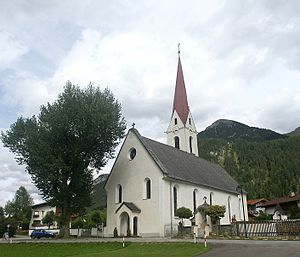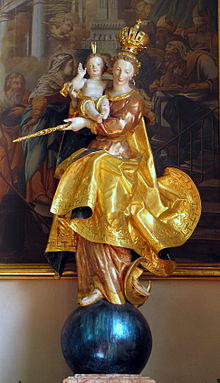Parish Church of Elmen
| Parish Church of the Three Kings | |
|---|---|
| Denomination : | Roman Catholic |
| Patronage : | Holy Three Kings |
| Consecration year : | 1444 |
| Parish : | Parish Church of Elmen |
| Address: | Elmen 248, 6644 Elmen |
Coordinates: 47 ° 20 ′ 25.6 ″ N , 10 ° 32 ′ 30.9 ″ E
The parish church of Elmen is in the Austrian municipality of Elmen in Tyrol . The Roman Catholic parish church of the Holy Three Kings belongs to the deanery of Breitenwang in the diocese of Innsbruck . The church with the cemetery, the chapel of the dead and the war memorial are, like the branch church Martinau, under monument protection ( list entry ).
history
Already at the beginning of the 15th century there was a church in Elmen, which was first mentioned in a document in 1438. In 1444 it appears that it was consecrated to the Three Kings and Our Lady. To subdivide the large parish of Elbigenalp, the Elmen chaplain was founded in 1515 and was then constantly manned by chaplains, who made it possible for the residents of the surrounding villages of Häselgehr-Gutschau, Stanzach, Vorder- and Hinterhornbach to be looked after. In 1667 the supposedly still Gothic church was badly damaged by the Widumbrand and received its present-day appearance after the immediate renovation and expansion measures. In 1786 the chaplain was elevated to a curate and finally in 1891 to a parish.
architecture
The nave and choir of the baroque building fit together - without any external plastic structure - under a shared gable roof. On the north side, at the transition from the nave to the choir, there is the bell tower from the 15th century, on which a pointed gable helmet was placed in 1903. The small portal porch adjoins the west facade, also under a gable roof. Above that there are two round windows, above which another circular window is built into the gable. The walled cemetery surrounds the church on three sides, which opens onto the street.
The nave with its four bays under a stitch cap barrel vault is followed by a retracted choir arch and the also retracted single-bay choir with a 3/8 end. The high floor level of the wide choir room is - unique in all of Tyrol - accessible from the nave via five steps.
The deep west gallery extends over two bays.
Furnishing
One of the most important works of art in the Ausserfern region is found in the church with the life-size crucified, which the keeper of Ehrenberg Burg Ehrenberg (Reutte) Burkhard Laymann von und zu Liebenau, Ehrenheim and Stainenberg commissioned from Bartholomäus Steinle from Weilheim in 1614.
The pulpit was built in the Lechleitner workshop in Grins around 1680, but it was not completed until about 60 years later with the 4 evangelists by Balthasar Jais.
The original baroque high altar (high altar I) fell victim to the classicist taste of the time in 1813. The extremely decorative sculptures of the Three Kings by Josef Georg Witwer from around 1774, which, without exaggeration, take on the status of a national attraction. Not related to the nativity scene, as is usual, these are free-standing on the high altar (high altar IV), which was reconstructed in 1964 by Wolfram Köberl in the Baroque style and designed as a platform for the important group. In terms of art history, the representation is exclusively as a church patron, and also in the "wrong" order, which is to be understood as an "allegory of prudence". This means: starting from the past (the old man = Balthasar), the present (middle age = Melchior) acts with caution so as not to disturb the action of the future (the youth = Caspar).
For one of the two former rococo side altars, one of which stood in the St. Josef branch church in Elmen-Martinau until 1903 and was then burned, the sculptor Johann Richard Eberhard from Hindelang made an important, extremely elegant figure of the Virgin (signed and dated 1784 ), which is set up today on the right side altar.
Around 1800 the fresco artist Joseph Anton Köpfle from Höfe received the order from curate Nicolaus Uelses to paint the entire shell of the church. Together with the gigantic ceiling fresco (dated 1801), which depicts the "Second Coming of Christ on Judgment Day", this extensive work forms his main work.
From the former classical high altar (high altar II), which the Imst sculptor Franz Xaver Renn himself erected in 1813, only two adoring entablature angels - also used again on the high altar erected in 1966 - and the statues of Luke and Johannes Baptist have been preserved. The latter are now on consoles on the choir walls! For this high altar, Karl Selb , born in Unterstockach, painted in 1814 - like Köpfle a pupil of Johann Jakob Zeiller - painted the large altar sheet with the “Adoration of the Magi”, which now hangs over the confessional in the nave. New altars in the style of historicism were finally purchased in 1876, with the racing figures at the high altar (No. III) being taken over.
Further altar paintings in the nave are again by Köpfle (signed and dated 1803). Balthasar Riepp painted the Stations of the Cross cycle around 1750 .
The organ with 14 registers was built by Anton Behmann in Schwarzach / Vorarlberg in 1909. In 1910 it was installed in the church that was specially extended for this work. The former baroque organ from Anwander from Hindelang had the same number of stops, but it was very compact. In contrast, the generous design of the Behmann organ now offers enough space for each individual register inside the case . In this way, the beauty of sound in the sense of romanticism can unfold in the best possible way. For this, of course, a good intonation is the prerequisite, to which Behmann attached great importance.
Bells
The peal in the parish church of Elmen has four steel bells that were cast in 1922 by the cast steel works Böhler from Kapfenberg.
The mood of the bells is:
- d 1 (consecrated to the Magi),
- f 1 (consecrated to St. Mary),
- g 1 (consecrated to St. John of Nepomuk) and
- a 1 (consecrated to St. Notburga).
It should be the only complete steel bell in the Lech Valley.
War memorial
The Pietà of the war memorial on the cemetery wall was created in 1925 by the sculptor Johann Schnitzer senior from Elmen.
literature
- Josef Mair and Herbert Wittmann: The sculptures of the artist family Witwer im Ausserfern from Imst , in: EXTRA VERREN 2013 (Yearbook of the Museum Association of the Reutte District).
- Josef Mair, in: The Reutte District "Das Ausserfern" , Reutte 2004, pp. 254f.
- Josef Mair: Laymann crucifixes by Bartholomäus Steinle in Elmen and Pflach , in: Tiroler Heimatblätter 1/2002, pp. 23-27.




